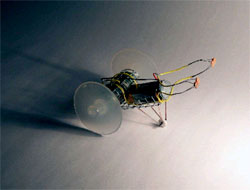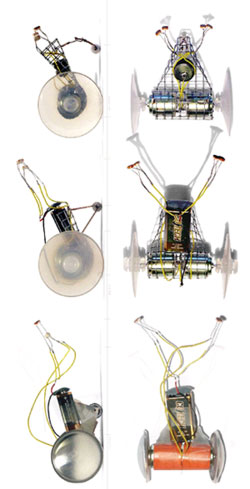Collaboration - A+URL
Architecture + Urban Research Laboratory
School of Architecture
Royal Institute of Technology, Stockholm
2002 fall - ongoing
Course organisation
Ana Betancour - course director
assitants
Harald Keier, Adam Somlai-Fischer,
Erik Wingquist, David Valldeby
Introduction
A + URL (Architecture + Urban Research Laboratory), is an intensive post-professional
course and postgraduate programme, and diploma course in architectural
design, leading to an International Masters of Architecture / or an Architecture
Diploma. The programme provides qualified applicants the opportunity to
develop advanced approaches and design skills, knowledge and expertise
in pursuit of the most pressing technological, cultural, theoretical,
and market-driven issues facing contemporary architecture.
Design as research
A + URL sees the design process as a field of research in architectural
and urban design aimed at developing alternative strategies and trajectories
that can drive and direct new forms of architecture and urbanity. The
point of departure of A + URL is to understand architecture and the city
as a dynamic system. Studio projects, design workshops and seminars, will
focus on emergent metabolic systems, spatial formations, and new organisational
patterns. Modes of working will be tested and develop further considerations
of the means of representation and different types of media. The programme
will develop project work, and research. The year programme is built up
through a sequence of connected studios, seminars, lectures and workshops.
It involves regular design based studios and theory lectures that structure
theoretical and practical basis of the course. We will concentrate on
the relationship between the mediated city and the physical city across
borderlines. This will involve making physical and electronic installations
(i.e. sensors) that link physical phenomena to virtual aspects, as well
as large-scale strategic proposals and detailed architectural and landscape
proposals.
2003 Cross border phenomena
Course Framework
The Mexican - American border is not only a legal boundary between
two countries. The border is strictly controlled, surveillance is maximal
and it forms an invisible division line between differing political, social,
and economical factors. Issues of representation of the 'other' occur
across this border. Today, the borderline has become the place where American
companies establish new factories in order to hire Mexican cheap-labour,
paying wages far below the American standards. The Mexicans commute daily
across the border for their workplace, and new settlements are expanding
adjacent to the borderline. The human and trade traffic is growing dramatically
and changing the landscape, the law and legal procedures, and the need
for facilities for the people living and working across the border.
A + URL will investigate and propose new functions and cross border spaces. We will explore the relationship across the borderline between Mexico and USA and borderline conditions on a range of scales.
The structure of the term is divided into three parts:
Module 01 Cross-border phenomenon and autonomous systems
We will investigate cross border phenomenon and develop skills in basic
electronics, sensors and feedback mechanisms.
Module 02 The trans-border city
Fieldwork and investigations across the border region of USA - Mexico,
developing critical ways of processing and visualize data /information.
We will make a field trip to Tijuana, Mexico.
Module 03 Interventions
Proposals and interventions involve aspects of cross border phenomenon,
film production facilities, representation and reality in propositions
connecting the US film industry (The USA's biggest industry) to employment
opportunities and other facilities as cross-border programmes.
Course Structure
General structure
In general the work for the year is considered as interrelated parts called
Modules which breakdown the work into parts. Between modules are shorter
Workshops that input other skills and issues such as critical theory or
base level skills into the development of the work
Thesis Project / Diploma work / project
The MA thesis project incorporates a portfolio-based project together
with a written thesis. The Diploma thesis project is set up to allow participants
to either develop own concerns or to further the work. Differences between
the participants level (MA, diploma or years 5 and years 4, exchange students)
will be taken into account.
Assessment
Assessment is according to the points system and according to satisfactory
completion of the module parts. Therefore for example one term's work
= 14 points.
02 Globalisation and trans-border urbanities
The mediated city is a new phenomenon involving the emergence of new technologies
of connectivity, network, communication and information technology. Additionally
while these factors are technological and in many ways not physical, they
are modifying economic, social, political aspects as much as they are
transforming the physical nature of cities and their relationships across
scales whether on the level of the virtual city or on the level of the
massive market of mobile phones in third world countries that are changing
the role of infrastructure, or on the level of 'network server farms'
that invisibly place demands on the city and its resources. These factors
are presently debated within sociologists, cultural studies writers and
more academic theorists, but are not actively dealt with by architects.
We will ask how architects can work with both cities; the physical and
the mediated
Borders are not only legal boundaries between two conditions, but are invisible division lines between differing political, cultural, social, and economical factors. Issues of representation and imagination of the 'other' occur across such lines. Cross border phenomenon speaks of bodies and entities that seek to transgress limits, to establish connections within a different realm and this occurs across various scales of existence:
In large scale geographic conditions of migration and displacement: people, goods, trade and culture etc
In political authorities concerned with implementations across Borough boundaries: Great London Authority, Thames Gateway etc EU
In the implementations of legal initiatives such as in networks and regeneration partnerships: City Side regeneration, Lea Side Regeneration, RENAISI etc, shengen, nafta
In the relationship between public and private space
In interdisciplinary initiatives and exchange
In everyday life, on a domestic scale such as a letter box
For further information please visit the A+Url website:
http://www.arch.kth.se/a-url
Selected Students works
The following are exemples from the ongoing course production.
Alexander Lang, Thomas Scherzer
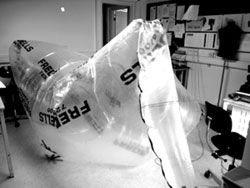
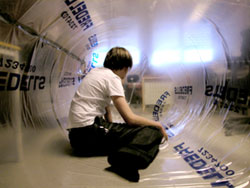
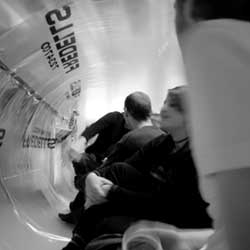
René Stöckigt, Joost
